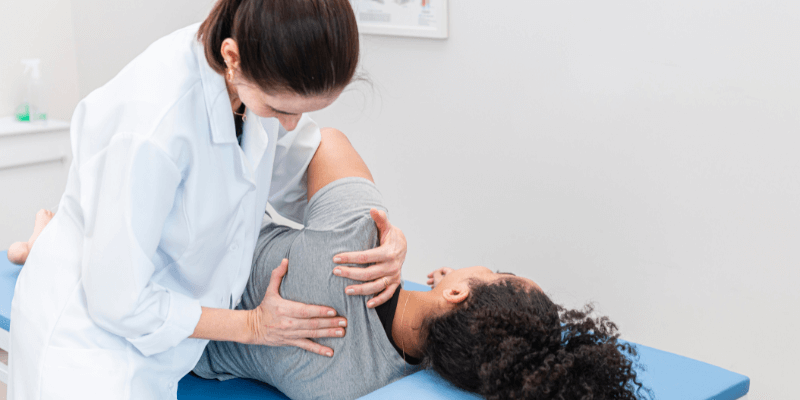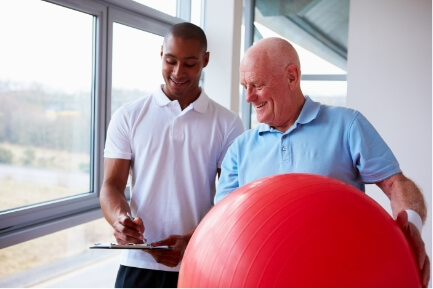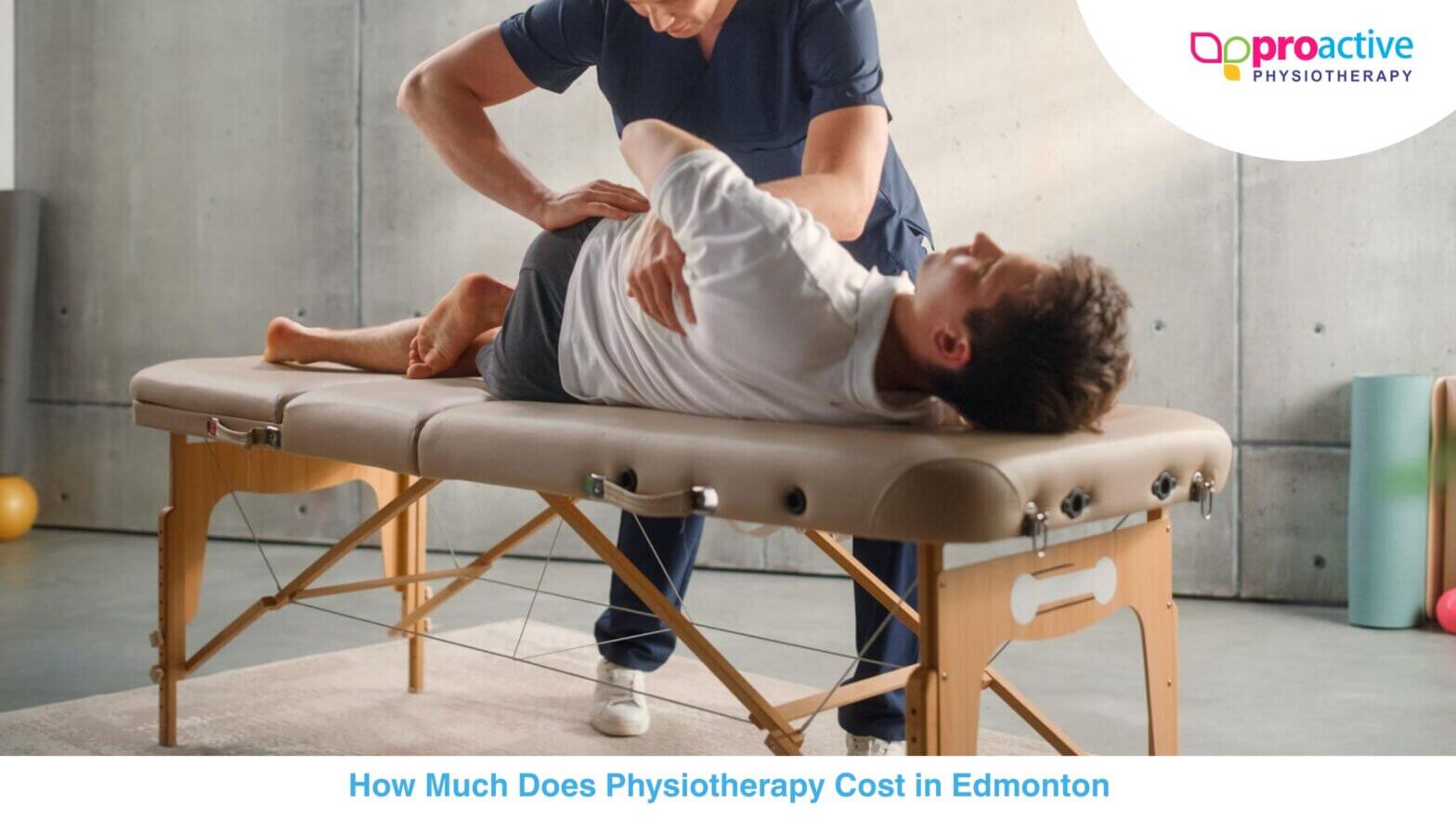Did you know that vestibular rehabilitation can be a game-changer for concussion patients? This therapy takes center stage. By focusing on improving the function of the vestibular system, which is responsible for our sense of balance, it helps patients regain control over their lives.
Concussions can disrupt the delicate workings of the vestibular system, leading to debilitating symptoms of traumatic brain injury. Vestibular physiotherapy targets this dysfunction head-on, addressing problems with vestibular input and neurovascular coupling in the semicircular canals of the inner ear. Through a comprehensive assessment that considers medical history and reflex testing, therapists identify specific areas of vestibular dysfunction that may contribute to motion sickness.
The treatment plan may involve exercises led by a physical therapist to strengthen the otolith organs or retrain postural reflexes for brain injury recovery. By gradually reintroducing functional movements and challenging the patient’s balance, vestibular rehabilitation aims to restore normal function. With its authoritative approach backed by evidence-based techniques, this exertional training therapy offers hope to those grappling with post-concussion symptoms.
So how does vestibular rehabilitation, including vision therapy and physical therapy exercises, work exactly? Let’s delve deeper into its various components and explore how it can make a significant difference in head injury and concussion recovery journeys.
Understanding Concussions: Causes, Symptoms, and Impacts on the Vestibular System
Concussions, a common result of head trauma or whiplash injuries, can occur during sports activities, falls, or accidents. These injuries can disrupt the normal functioning of the vestibular system and have various effects on the body. Vision therapy and cognitive fx can be beneficial in treating brain injuries.
Symptoms of concussions, such as headache, dizziness, nausea, and sensitivity to light or noise, can be debilitating and affect daily life for those with vestibular problems. In some cases, individuals may experience a condition known as concussion syndrome where symptoms of vestibular dysfunction persist for an extended period.
The vestibular system, which is responsible for maintaining balance and coordinating head movements with eye movements, plays a crucial role in our sensory system. When a brain injury like a concussion occurs, it can directly impact the function of the vestibular system. This can be addressed through physical therapy.
One of the primary effects of head injury, such as concussions, on the brain’s vestibular system is dizziness or vertigo. Individuals may experience dysfunction in their vision and feel like their surroundings are spinning or that they are off-balance even when standing still. This sensation can be disorienting and make it challenging to perform everyday tasks.
Head movements can also become problematic for individuals with concussions and vestibular issues. Simple actions like turning your head quickly or looking up can trigger dizziness or worsen existing symptoms of vestibular dysfunction. This limitation affects mobility and can lead to difficulties in performing regular activities such as driving or exercising. Vestibular therapists can help address these challenges by targeting the brain’s vestibular system.
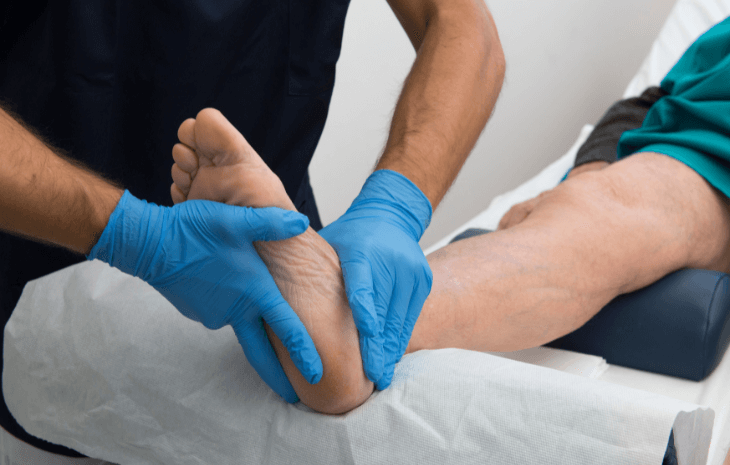
In addition to balance disorders, concussions can affect other aspects of brain function related to the vestibular system, causing dysfunction. Cognitive functions such as memory, attention span, and concentration may be impaired following a concussion injury. This cognitive fog further exacerbates the challenges faced by individuals recovering from concussions and may require physical therapy for vision rehabilitation.
Vestibular physiotherapy has emerged as an effective treatment option for those suffering from vestibular symptoms due to brain injuries. This specialized form of physiotherapy focuses on improving balance, reducing dizziness, and restoring normal vision and brain function.
During vestibular physiotherapy sessions, therapists use various techniques to stimulate the vestibular system and promote recovery from concussion syndrome. These techniques may include specific exercises to improve balance and vision, eye-head coordination exercises, and habituation exercises to reduce sensitivity to motion, which are common concussion symptoms caused by brain injuries.
Exploring the Benefits of Vestibular Therapy for Concussion Recovery
Reducing Symptoms and Restoring Balance
Vestibular therapy is a highly effective treatment for individuals recovering from brain concussions. One of its primary benefits is the reduction of symptoms such as dizziness and imbalance that are commonly experienced after a concussion. By targeting the brain’s vestibular system, this therapy helps restore normal function and alleviate these distressing symptoms.
During a concussion, the delicate structures within the brain’s inner ear can be affected, leading to vestibular issues. These brain-related issues can result in feelings of vertigo or positional vertigo, where one’s perception of their body’s position in space becomes distorted. Vestibular therapy specifically addresses these problems by employing various exercises and techniques that target the brain’s vestibular system.
Improving Coordination and Enhancing Functionality
In addition to reducing symptoms, vestibular therapy also plays a crucial role in improving coordination and spatial awareness during concussion recovery. The disruption caused by a concussion can negatively impact an individual’s ability to carry out everyday tasks with ease. By focusing on exercises that enhance coordination and spatial awareness, vestibular therapy helps individuals regain control over their movements and supports the healing of the brain.
Through specific exercises like balance training and eye-tracking activities, physical therapy patients gradually retrain their brains to process sensory information more effectively. This leads to improved coordination between different parts of the body and better overall functionality for those with vestibular dysfunction and vestibular symptoms.
Enhancing Quality of Life During Recovery
Concussion recovery can be a challenging time for individuals as they navigate through physical and cognitive changes in the brain. Vestibular therapy offers significant benefits beyond symptom reduction by enhancing overall quality of life during this brain recovery period.
By addressing both the physical and cognitive aspects of the brain, vestibular therapy helps individuals regain confidence in their brain’s abilities. It allows them to engage in daily activities without fear of exacerbating their brain-related symptoms or experiencing setbacks. This newfound independence contributes positively to mental well-being throughout the recovery process.
Furthermore, engaging in vestibular therapy can be an empowering experience for individuals recovering from concussions. It provides them with a sense of control and agency over their brain recovery journey. With the guidance of a trained therapist, they actively participate in their brain rehabilitation, which can significantly boost motivation and overall progress.
Key Components of Effective Vestibular Rehabilitation for Concussion Patients
Assessment by a Trained Professional
Before starting any vestibular rehabilitation program, it is crucial for concussion patients to undergo a thorough assessment by a trained professional. This assessment helps identify the specific impairments and challenges faced by the individual’s brain, allowing the physiotherapist to design an effective treatment plan. The assessment may include various tests such as visual tracking assessments, balance evaluations, and symptom questionnaires. By understanding the unique needs of each patient’s brain, the physiotherapist can tailor the rehabilitation program accordingly.
Exercises Targeting Gaze Stability, Balance, and Habituation
Gaze stability exercises are essential for vestibular rehabilitation after concussions. These exercises improve eye movement control and alleviate symptoms like dizziness and nausea. One common exercise involves fixing your gaze on a stationary object while moving your head, training your eyes to stay focused even when your brain is in motion.
Balance exercises are another key component of vestibular rehabilitation that help improve postural stability and reduce the risk of falls. These exercises are beneficial for the brain and CT speech. Examples include standing on one leg with eyes closed, walking along a straight line heel-to-toe, or performing gentle rocking movements while standing.
Habituation exercises are designed to desensitize patients with vestibular dysfunction to certain movements that trigger their symptoms. These exercises involve gradually exposing individuals to activities that provoke dizziness or imbalance in a controlled manner until their tolerance improves over time. By doing so, these exercises help train the brain to adapt and reduce symptoms associated with vestibular dysfunction.
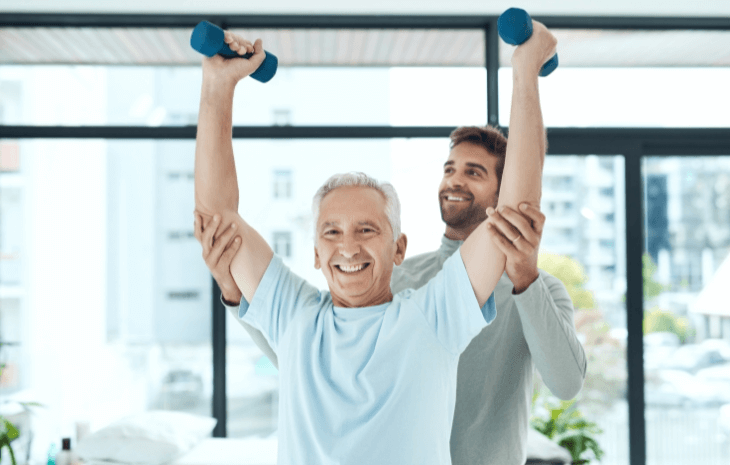
Gradual Progression and Individualized Programs
Vestibular rehabilitation programs should be tailored to each patient’s specific needs and abilities. It is essential to start with exercises that are within the patient’s comfort zone while gradually increasing difficulty over time. This gradual progression allows the brain and vestibular system to adapt without overwhelming the individual.
Individualized physiotherapy programs also consider the brain, vestibular dysfunction, and vestibular symptoms that may affect recovery. These programs take into account factors such as age, overall health, and the presence of other medical conditions to provide a more comprehensive and effective treatment plan.
Establishing an Individualized Vestibular Therapy Plan for Optimal Results
Personalizing the Treatment Plan
A personalized therapy plan is crucial in addressing vestibular dysfunction and optimizing brain function. Each patient’s unique symptoms and needs require a tailored treatment plan that considers their vision, balance system, and spatial orientation. By targeting the specific areas that need attention, an individualized approach can be developed to ensure optimal results.
Assessing Symptoms and Goals
The first step in establishing a personalized therapy plan is conducting a thorough assessment of the patient’s brain condition. This evaluation involves various tests and examinations to identify specific issues related to the brain’s vestibular system. Positional testing helps determine if any ear crystals are out of place in the brain, while assessments of eye movements provide insights into functional vision in the brain. By understanding these underlying problems in the brain, therapists can set realistic goals for the treatment plan.
Eye Movements and Head Motions
Eye movements play a significant role in our overall balance and spatial orientation, as well as in the functioning of the brain. In vestibular physiotherapy, exercises targeting eye movements are often included in the treatment plan to improve coordination between eye movements and head motions, which can be impaired following a concussion. Therapists may prescribe specific eye movement exercises like tracking objects or shifting focus between near and far distances to enhance brain function.
Head motions are another crucial aspect addressed during vestibular therapy sessions. Certain head motions may trigger dizziness or imbalance for individuals with concussions. Through gradual exposure and controlled repetition of these motions, patients can gradually regain their ability to perform daily activities without experiencing discomfort or instability.
Balance Training
Balance training is an integral part of vestibular physiotherapy for concussions. It aims to strengthen the body’s balance system by challenging it through various exercises, including the use of a ct app.
- Standing on one leg while maintaining stability
- Performing dynamic movements like lunges or squats
- Engaging in activities that require shifting weight from one foot to another can be challenging for individuals with vestibular dysfunction.
By progressively challenging the balance system, patients with vestibular dysfunction can regain their stability and reduce symptoms such as dizziness or unsteadiness.
Regular Reassessment and Adjustments
Throughout the treatment plan for patients with vestibular dysfunction, regular reassessment is vital to ensure progress and make any necessary adjustments. As patients work through their therapy sessions, therapists continuously monitor their improvement and evaluate if any modifications are needed. This stepwise return assessment allows for a personalized approach that adapts to each patient’s changing needs.
By regularly reassessing the individual’s condition, therapists can modify the exercises or techniques used in therapy sessions for patients with vestibular dysfunction. This flexibility ensures that the treatment plan remains effective and aligned with the patient’s goals related to their vestibular dysfunction.
Home Exercises for Vestibular Rehabilitation: Empowering Patients in their Recovery
Home exercises play a crucial role in complementing in-clinic sessions for individuals undergoing vestibular physiotherapy for concussions. These exercises not only accelerate the recovery progress but also empower patients to take an active role in their own healing journey. By focusing on promoting vestibular adaptation and strengthening muscles, these home exercises provide patients with the tools they need to regain balance, reduce dizziness, and improve overall function.
Vestibular Exercises
Vestibular exercises are designed to stimulate and challenge the vestibular system, which is responsible for maintaining balance and spatial orientation. These exercises help promote adaptation and compensation, allowing patients to regain their equilibrium more effectively. Some examples of vestibular exercises include:
- Vestibular Dysfunction: Gaze Stabilization Exercises for Vestibular Dysfunction involve fixing your gaze on a stable object while moving your head or body. This helps train the brain to process visual information accurately during movement.
- Habituation Exercises: These exercises involve exposing yourself gradually to movements or activities that trigger dizziness or imbalance. Over time, repeated exposure helps desensitize the brain’s response and reduce symptoms.
- Balance Exercises: Balance training is essential for improving stability and reducing the risk of falls. It involves performing various standing and dynamic movements that challenge your balance control.
Cognitive Exercises
Concussions can often affect cognitive function, leading to difficulties with memory, attention, and concentration. Incorporating cognitive exercises into a home exercise program can help address these issues by stimulating neural pathways involved in cognitive processing. Some cognitive exercises that can be beneficial include:
- Memory Games: Engaging in memory games like puzzles or card matching activities can help improve memory recall and enhance cognitive abilities.
- Attention Training: Activities such as reading aloud while counting backward or focusing on specific details in a picture can help improve attention span and concentration.
- Multitasking Exercises: Performing tasks that require simultaneous attention and coordination, such as cooking while following a recipe or listening to music while doing household chores, can help improve multitasking abilities.
Exertional Training
Exertional training involves gradually increasing physical activity levels to improve endurance and tolerance. This type of exercise is particularly important for individuals who have experienced concussions, as it helps them regain their ability to perform daily activities without experiencing excessive fatigue or symptoms. Some examples of exertional training exercises include:
- Cardio Exercise: Engaging in low-impact cardiovascular exercises like walking, swimming, or cycling can help improve cardiovascular fitness and overall stamina.
- Interval Training: Alternating periods of high-intensity exercise with periods of rest can help build endurance and increase tolerance for physical activity.
- Strength Training: Incorporating resistance exercises using bodyweight or light weights can help strengthen muscles and support better movement control.
Finding the Right Vestibular Therapist: Factors to Consider for Successful Treatment
There are several factors you should consider. The expertise and approach of the therapist can greatly impact your recovery process. To ensure successful treatment, evaluate the following factors before making a decision.
Experience in Treating Concussions and Vestibular Disorders
One of the most important factors to consider when choosing a vestibular therapist is their experience in treating concussions and vestibular disorders. Look for therapists who have a proven track record in successfully helping patients with similar conditions. An experienced therapist will be familiar with the unique challenges that concussions present and will have developed effective strategies for addressing them.
Knowledge of Latest Research and Treatment Techniques
Concussion treatments are constantly evolving as new research emerges. It’s crucial to find a therapist who stays up-to-date with the latest advancements in vestibular physiotherapy. Ask potential therapists about their ongoing education and involvement in professional development activities. A knowledgeable therapist will be able to provide you with evidence-based treatments that align with current best practices.
Individualized Care and Rapport with Patients
Every patient is different, and an effective vestibular therapist understands this. Look for someone who provides individualized care tailored to your specific needs. They should take the time to conduct a thorough evaluation today, considering all aspects of your condition before developing a treatment plan. Having good rapport with your therapist is essential as it fosters trust, communication, and collaboration throughout your recovery journey.
Multidisciplinary Approach
Vestibular therapy often requires collaboration between different healthcare professionals to address various aspects of concussion recovery effectively. Consider therapists who work alongside other specialists such as physical therapists or speech therapists. A multidisciplinary approach ensures comprehensive care by targeting different areas impacted by concussions simultaneously.
Specialization in Vestibular Therapy
While many physical therapists may have some knowledge of vestibular therapy, it’s beneficial to seek out specialists who focus specifically on this area. A vestibular therapist with specialized training and experience will have a deeper understanding of the intricacies involved in treating vestibular disorders caused by concussions. They will be equipped with a broader range of treatment techniques and interventions specific to your needs.

Types of Treatment Offered
Different therapists may offer varying types of treatments for vestibular rehabilitation. Familiarize yourself with the options available and discuss them with potential therapists. Here are some common treatment approaches:
- Canalith repositioning maneuvers: These maneuvers help reposition displaced calcium crystals in the inner ear, alleviating symptoms like dizziness and vertigo.
- Balance exercises: Therapists may prescribe specific exercises to improve balance, stability, and coordination.
- Gaze stabilization exercises: These exercises aim to improve eye movements and reduce symptoms such as blurred vision or difficulty focusing.
- Vestibular habituation exercises: Gradual exposure to movements that trigger symptoms helps desensitize the brain, reducing dizziness over time.
FAQs
Q: How long does it typically take to recover from a concussion with vestibular therapy?
A: The duration of recovery varies depending on the severity of the concussion and individual factors. While some individuals may experience improvement within a few weeks, others may require several months of vestibular therapy to achieve a full recovery.
Q: Can vestibular therapy help with other symptoms commonly associated with concussions?
A: Yes, vestibular therapy can also address symptoms such as headaches, visual disturbances, and cognitive difficulties that often accompany concussions. By improving overall balance and function, it contributes to a comprehensive recovery process.
Q: Is vestibular physiotherapy suitable for all ages?
A: Vestibular therapy can benefit individuals of all ages, from children to older adults. Treatment plans are tailored to meet the unique needs and capabilities of each patient, ensuring safe and effective rehabilitation.
Q: Are there any potential side effects or risks associated with vestibular therapy?
A: When performed by qualified professionals, vestibular therapy is generally safe. However, some individuals may experience temporary increased dizziness or discomfort during certain exercises. These sensations typically diminish as treatment progresses.
Q: Can I continue my regular activities while undergoing vestibular therapy?
A: It is essential to discuss your specific situation with your vestibular therapist. In many cases, modifications or temporary restrictions may be necessary to avoid exacerbating symptoms or hindering progress. Your therapist will provide guidance on gradually reintroducing activities as part of your rehabilitation plan.
Achieving a Full Recovery with Vestibular Therapy for Concussions
In conclusion, vestibular physiotherapy is a crucial component in the recovery process for individuals who have experienced concussions. By understanding the causes, symptoms, and impacts of concussions on the vestibular system, we can better appreciate the importance of targeted rehabilitation. Vestibular therapy offers numerous benefits for concussion recovery, including improved balance, reduced dizziness, and enhanced overall function.
To maximize results, effective vestibular rehabilitation should encompass key components such as gaze stabilization exercises, balance training, and habituation techniques. These tailored treatment plans are designed to address the specific needs of each individual patient and promote optimal healing.

